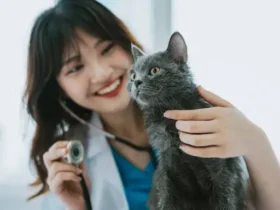Introduction
If you’ve ever had a cat lick your hand, you’ve likely noticed that their tongue feels surprisingly rough, almost like sandpaper. This unique texture is not just a quirky trait; it serves several essential functions that are key to a cat’s survival and daily life. But why exactly are cats’ tongues rough? In this blog, we’ll explore the fascinating anatomy of a cat’s tongue, how it benefits them in various ways, and what it reveals about their wild ancestors.
The Anatomy of a Cat’s Tongue
A cat’s tongue is covered in tiny, hook-like structures called papillae. These papillae are made of keratin, the same material found in human fingernails. Unlike the smooth texture of human tongues, these papillae give a cat’s tongue its rough, sandpaper-like feel.
Papillae: Nature’s Perfect Tool
The papillae on a cat’s tongue are not just randomly placed; they are arranged in a backward-facing manner, resembling tiny hooks or spines. This arrangement is crucial for the various tasks that a cat’s tongue must perform, from grooming to eating.
The Role of a Rough Tongue in Grooming
One of the most well-known uses of a cat’s rough tongue is for grooming. Cats are meticulous groomers, spending a significant portion of their day licking their fur. The rough texture of their tongue helps them remove dirt, loose hair, and parasites from their coat.
Removing Loose Fur
The backward-facing papillae act like a natural comb, catching loose fur and pulling it away from the body. This is why you often find fur in a cat’s mouth or see them coughing up hairballs. The rough tongue is incredibly effective at keeping a cat’s fur clean and free of debris.
Distributing Natural Oils
In addition to removing loose fur and dirt, a cat’s tongue also helps distribute natural oils produced by their skin. These oils keep their fur smooth and shiny, providing a layer of protection against the elements.
The Hunting Advantage: Eating Prey
In the wild, cats are natural hunters, and their rough tongues play a crucial role in their ability to consume prey efficiently.
Stripping Meat from Bones
The backward-facing papillae on a cat’s tongue are perfectly designed to strip meat from bones. When a cat catches its prey, it uses its tongue to rasp the flesh off, leaving behind only the bones. This ability is not just a throwback to their wild ancestors; it is essential for survival in the wild, where every bit of meat counts.
Lapping Up Liquids
Cats are also known for their unique way of drinking water. They use their tongue to create a column of liquid, which they then quickly close their mouth around. The rough texture of their tongue helps in forming this column, allowing them to lap up liquids efficiently without needing to submerge their mouth.
The Connection to Wild Ancestors
The rough texture of a cat’s tongue is a direct link to their wild ancestors. Big cats, like lions and tigers, also have rough tongues with similar papillae. These large felines rely on their tongues not only for grooming but also for consuming large prey. The fact that domestic cats share this trait with their wild cousins is a testament to their shared evolutionary history.
Health Implications of a Rough Tongue
While a rough tongue is beneficial in many ways, it can also pose some health risks for cats.
Hairballs and Digestive Issues
Because a cat’s tongue is so effective at catching loose fur, they often swallow a significant amount of it while grooming. This can lead to the formation of hairballs, which can sometimes cause digestive issues if not expelled properly. Regular grooming by the owner can help reduce the amount of loose fur a cat swallows, minimizing the risk of hairballs.
The Risk of Foreign Objects
The backward-facing papillae on a cat’s tongue can also cause problems if they pick up foreign objects, such as string or small toys. Once something gets caught on their tongue, it can be challenging for the cat to remove it on its own, leading to potential choking hazards or digestive blockages.
Fascinating Facts About Cats’ Tongues
Cats’ Tongues Are Temperature Sensitive
Interestingly, cats’ tongues are highly sensitive to temperature. This sensitivity helps them gauge the temperature of food or liquids before consuming them, ensuring that they don’t burn themselves or eat something too cold, which could shock their system.
Cats Can’t Taste Sweetness
Despite their love for certain treats, cats cannot taste sweetness. Their tongues lack the taste receptors for sweet flavors, which is why they are indifferent to sugary foods. This is an evolutionary trait, as their carnivorous diet in the wild did not require them to seek out sweet foods.
Tongue as a Communication Tool
Cats also use their tongues as a means of communication. When a cat licks you, it’s not just a grooming behavior; it’s also a sign of affection and bonding. In the wild, cats will groom each other to reinforce social bonds, and domestic cats often extend this behavior to their human companions.
Conclusion
The rough texture of a cat’s tongue is more than just a curious quirk; it’s a vital tool that serves multiple functions in their daily lives. From grooming and eating to communication and survival, a cat’s tongue is a marvel of nature’s design. Understanding why cats’ tongues are rough gives us deeper insight into their behavior, health, and connection to their wild ancestors.
So, the next time your cat gives you a lick, remember that it’s not just showing affection—it’s also demonstrating the incredible adaptations that have helped cats thrive for thousands of years.










Leave a Reply